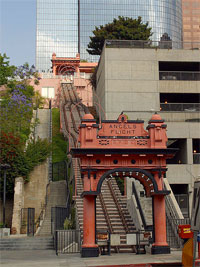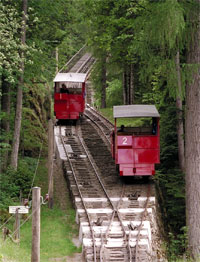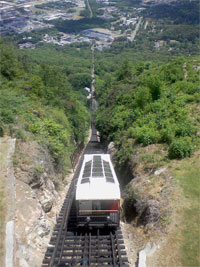Humans have been using funiculars for close to 500 years to transport people and cargo up steep inclines, and in that time, the technology has not changed significantly. Initially developed to move through steep terrain, funiculars remain relevant because of their efficiency and simplicity of design. By using a counterweight pulley system, the funicular uses the kinetic energy of the descending car to raise the ascending car in a manner similar to that of an elevator. This works in combination with wheeled cars and tracks to allow for long routes and reliable rides. Although some added energy is required to overcome frictional losses of the system, funiculars represent a sustainable method of transportation because no fuel is consumed. Instead, funiculars harness the energy inherent in the motion of the cars. These railways demonstrate the lasting value of simple solutions and are a testament to engineering ingenuity.
Introduction
Humankind has made some impressive technological advancements in our relatively brief time on Earth – landing a spacecraft on the moon, diving to the ocean floor, zipping across land in magnetic levitation trains. In this high-paced world, it can be easy to overlook the magnitude of the accomplishments of centuries past. However, there are lessons to be learned and beauty to be found in the simplicity of many ancient technologies. Before the days of electricity and steam engines, humans still managed to erect the Pyramids, sail the oceans in wooden ships, and pump water in aqueducts. One example of human ingenuity is the funicular railway (also called an incline railway). Using a simple pulley system, the funicular railway allows passengers and cargo to be carried up mountains with minimal energy expenditure. The elegantly efficient design of the funicular has not changed a great deal over its 500-year lifetime.
Origins and History
Many of us have probably never heard of funicular railways, or if we have, it may have been in the context of a tourist attraction. As a long-time resident of Los Angeles, I was surprised to learn quite recently that one exists right here in downtown Los Angeles, on Bunker Hill. When I finally got a chance to see it, I got the impression that it was more of a historical novelty than a practical mode of transportation in modern society. However, upon further research, I realized that this type of railway continues to be a useful addition to the public transportation systems of cities all over the world. Similar technology has also been adapted by companies for use in more residential or commercial settings, at ski resorts or golf courses, for example. Even though funiculars serve a fairly narrow range of transportation needs, they do so in such an effective manner that many of those running today have been in operation for over a hundred years. Because they are so uniquely suited to such a specific purpose, funiculars remain relevant to this day.
Funicular railways were developed in response to the needs of very specific terrain problems – namely moving cargo up and down inclines, or rapid changes in elevation. The first predecessor of the modern funicular railway was developed in the 1500s at Hohensalzburg Castle in Salzburg. It ran on wooden tracks and consisted of one cart attached to a pulley, powered first by prisoners, then by oxen [1]. Funiculars grew in popularity during the 18th century in the Industrial Age; they were especially useful along canals to help move barges over elevation changes that were too steep for locks [2]. Many of those that exist in the eastern United States were originally created for this purpose, as well as cities in South America and other parts of the world. Some cities situated on steep mountains like Valparaiso, Chile, depend on funicular railways to connect the different levels of the city. Because funiculars provide an efficient method of traversing inclines that requires little physical exertion from users, they have been implemented on hills and mountains across the globe.
Like an Elevator, Like a Train
On a basic level, the funicular can be described as a hybrid of the technologies behind elevators and trains, although it predated both of these. The typical modern construction involves two cargo or passenger cars attached by a cable around a pulley running along a track (Fig. 1). The funicular runs because cars act as counterweights for each other, a system also employed by elevators. This is supplemented by hydraulic systems or an electric motor to overcome the friction losses in the system and the variable weights of the cars. Since many that were built along canals had pretty easy access to water, they could be hydraulically powered, either by using the water to turn a turbine or by using water as weight. The oldest running funicular of this kind exists in Braga, Portugal.
Funiculars differ from elevators in that they run along the ground, allowing them to traverse much longer routes. Although some are quite limited in range, like Angel’s Flight in downtown Los Angeles, routes can reach maximum lengths of 2.6 miles (connecting the towns of Sierre, Montana, and Crans in Switzerland)[3]. Regardless of their length, all funiculars use rails to guide the wheels of the car for smooth and reliable travel, making them a close relative to trains. However, a train could never handle the steep slopes that a funicular can service. The steepest existing one, located in Katoomba, New South Wales, Australia, has a gradient of 74%, or it rises 74 feet for every 100 feet of horizontal distance [4]. The funicular’s unique combination of a counterweight pulley system and railroad tracks allows it to use a minimum amount of energy to navigate difficult terrain.
Energy Efficiency
The key to the energy efficiency of the funicular railway is the use of the second car as a counterweight. Climbing an incline requires work input to counter the effects of gravitational forces. Because there is a large increase in the potential energy of the car and because energy is always conserved, there must be a source of energy to perform the lifting. In the past, trains relied on human or animal power as their primary energy source in lifting their mass over the incline; the funicular uses its two cars as counterweights. When one car ascends, the other descends, effectively converting most of the potential energy of one car into the potential energy of the other car. Because of the frictional losses inherent in the system (between the wheels and the rails, the cable and the pulley, and the air resistance to the cable’s motion), there must be a small addition of energy. In the past, this was accomplished by the addition of weight (usually water) to the descending cart so as to increase the potential energy to the point where it overcomes the frictional losses on both sides. More commonly, the extra source of energy comes from an electric motor that controls the rotation of the pulley. Having two cars run at once not only increases the passenger capacity of the railway, but also makes it possible to retain energy by passing it back and forth between the cars.
Rails and Tracks
In this counterweight mechanism, the funicular railways require a track to guide the cars along their routes. Initially, a separate track was built for each car, resulting in four rails side-by-side. However, during a project on Mount Lowe in the San Gabriel Mountains, project financier and civil engineer Thaddeus Lowe came up with a “three railed incline” to save the amount of space that needed to be graded and amount of track that needed to be laid down [5]. Basically, the two cars share an inner rail, except at the midpoint where the track splits once again to four rails, so that the cars can pass each other safely. Others were eventually built that have only two rails where the cars are not passing, further decreasing the need for materials and space. Fig. 2 demonstrates such a track. The first tracks were made of wood and were created to ease the damage to the wheels by providing a uniform surface that avoided variable ground conditions like mud or rocky outcrops. With the more advanced manufacturing abilities of the Industrial Revolution, the wooden tracks became steel and flat wheels became flanged or grooved to better grip the rails [6].
Wheels
While wheels are important for guidance, the wheels of a funicular railway do much less work than those of a regular train. Trains move forward due to the rotation of the wheels, made possible by the rolling friction between the wheel and track. Without this source of friction, the train would slide instead of roll. This reveals why trains cannot climb the same inclines that funiculars can. Even with the power of its steam engine, a train could not easily maintain upward rolling motion because steel wheels do not have enough traction to combat the downward gravitational forces. Using a material for the wheels that has a higher coefficient of friction, like rubber, does not solve the problem because it also has increased rolling resistance that impedes motion and requires more input energy to maintain velocity [7]. The only way for trains to handle steep inclines is to use switchbacks, which are costly and take up a great deal of space. Funiculars bypass this problem because they do not require the rolling mechanism to provide the driving force. Instead, the pulley and cable system provides the upward motion, while the wheels merely keep the car on track.
Cable and Pulley System
The genius of the funicular is in its use of the cable and pulley to harness the energy of the descending car to pull the ascending one. Most systems either have one continuous loop run the entire length of the track or have the cable connect the upper end of one car to the upper end of the other. The cable must be kept taut to prevent sliding and, in systems where the cars share a rail, to prevent the cars from crashing. When the cable is continuous, there is a counterweight in the lower station to sustain the proper amount of tension throughout the loop; this is a difficult task due to the kinetic friction from the motion of the cable, which heats the steel of the cable and causes it to expand [8]. In systems with very long cables (like the 2.5 mile cable connecting Sierre – Montana – Crans), there must be a mechanism that adds or removes extra weight from the cable to prevent it from going slack [3]. The cables wind around large pulleys with grips on the exterior that allow for controlled rotation and prevent runaway cars. The pulley allows the force of the descending car to be redirected toward lifting the ascending car.
Safety Considerations
Safety is one of the major challenges in every engineering project, and the developers of funicular railways put several different measures in place to curtail the chance of system failure. The straightforward design of the funicular limits the number of breakdowns that can occur. The first major concern is the tensile strength of the steel cables. The design of the system should overestimate the maximum load the cars will be carrying so that there will not be a situation where the cable snaps under stress. In the event of an emergency (including “overspeed or a slack haul rope”), every funicular comes equipped with emergency rail brakes, which resemble clamps that automatically grip the rail to bring the car to a safe stop [8]. If the entire track cannot be seen clearly from each loading station, there is usually an operator on board the funicular to watch for blockage on the tracks and other obstacles. Other considerations adopted by Doppelmayr, one of the world’s leading manufacturers of funiculars and other ropeway systems, include “hydrostatic auxiliary or emergency drives” (that take over the electrical operations in case of a power outage) and steps along the tracks (for safe passenger evacuation). Because funiculars have a relatively simple design, the opportunities for malfunctions to occur are few, and existing safety measures can adequately protect passengers.
Funicular designs have undergone many changes over the years, but the original cable mechanism is still the safest option (Fig. 3). An illustration of the original engineering can be found in the story of Angel’s Flight in Los Angeles. Originally opened in 1901, the railway was closed in 1966 during renovations to Bunker Hill. In 1996, it was reopened as an important city landmark, but in the rebuilding, the cars were each cabled separately to the top station, instead of being connected. Five years later, there was an accident when a faulty cable gear mechanism broke, sending one car crashing down into the other, killing one person and injuring seven others. Because of the short length of the railway, the emergency brakes did not have time to stop the car before collision. The railway closed immediately for repairs and has plans to re-open in the near future with “the original funicular engineering” and “several redundant braking systems” [9]. It is interesting to note that the original cable mechanism would not have allowed this accident to happen because, in the words of John Welbourne, president of the Angels Flight Railway Foundation, “It’s impossible for the cars to occupy the same space at the same time” unless the cable snaps, which it did not in this case [9]. In terms of antique technology, the robust and efficient design of funiculars has endured.
Conclusion
Although funicular railways have been around for hundreds of years, they continue to provide a practical method of transportation because they fill the particular niche of steep incline conveyance so effectively. With an efficient counterweight system and numerous safety precautions, they are more than charming historical attractions. Systems that were installed over 100 years ago continue to carry commuters and tourists alike in cities and towns worldwide. Funiculars are a prime example of the engineering ingenuity found throughout history and demonstrate the value that older and simpler technologies can continue to have in the modern world.






